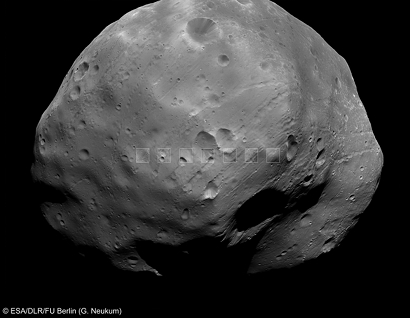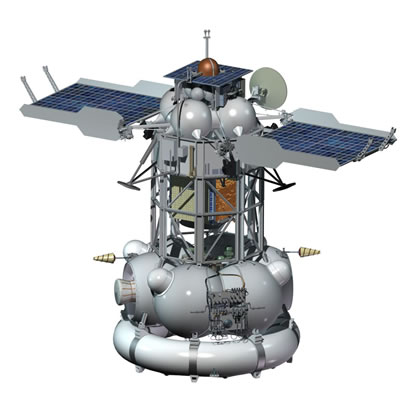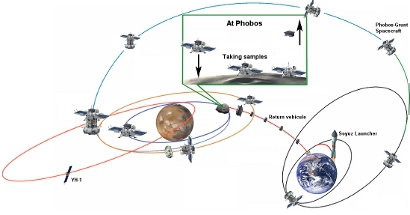Phobos-Soil mission summary
 |
|
Mars Express view of Phobos. Credit: ESA/DLR/FU Berlin (G. Neukum) |
Phobos-Soil (also known by its Russian name: Phobos-Grunt) was designed for a comprehensive study of the larger of the two Martian moons – the first spacecraft dedicated to studying this particular planetary body. The mission consisted of a spacecraft that would observe Phobos and its environment from orbit, a lander that would study it in situ, and a return module that would bring about 100 cubic centimetres of samples from the mysterious moon back to Earth.
This pioneering mission was first proposed by the Council on Space of the Russian Academy of Sciences. It was implemented by the Russian Federal Space Agency (Roscosmos) and NPO Lavochkin Association was the prime contractor for the space segment.
 |
|
Phobos-Soil (Phobos-Grunt) spacecraft design. Credit: Lavochkin Association |
The Chinese orbiter, Yinghuo-1– the first Chinese mission to Mars – piggybacked with the mission and was to be delivered in orbit around the Red Planet.
The Phobos-Soil spacecraft carried a payload of eighteen instruments; several developed with significant cooperation of ESA and European research institutes.
In exchange for ESA ground station support, European researchers were guaranteed access to proprietary Phobos-Soil data through a Guest Investigator Programme established via an agreement between ESA and Roscosmos.
The spacecraft launched from the Baikonur Cosmodrome in Kazakhstan on 8 November 2011. After initial problems that failed to set Phobos-Soil on its interplanetary trajectory to Mars from its position in low Earth orbit, communication with the spacecraft was established only intermittently. After several failed attempts, Roscosmos declared the spacecraft dead; it eventually reentered Earth's atmosphere and crashed into the Pacific ocean on 15 January 2012.
A pioneering mission
A succession of different spacecraft, some carrying rovers or landers, have flown to and studied Mars. A handful of these explorers are currently in orbit or on the surface and are helping increase our knowledge of the Red Planet. However, the two moons of Mars, Phobos and Deimos, remain relatively unstudied.
So far, the two moons have been studied remotely by Mars-orbiting spacecraft. They have also been briefly observed during close fly-bys, which have revealed many unusual features. For the time being, a reasonable explanation of the composition and origin of the Martian moons remains a matter of debate.
Phobos-Soil was designed to provide new insight to these fields of research by investigating its target's environment from its position in a quasi-synchronous orbit around the moon; studying the physical and chemical properties of the regolith at the landing site; and measuring its bulk characteristics. The samples of the moon sent back in the return module were to be analysed thoroughly in terrestrial laboratories.
In addition to enhancing our knowledge of its origin and evolution, the study of Phobos would reveal new information about its shared history with Mars, and tell us more about the Red Planet itself.
The prospective landing site for Phobos-Soil (7°N to 21°N and 214°W to 233°W) was chosen based on image data acquired by Mars Express. The actual site would be decided based on observations from orbit, the spacecraft trajectory around the moon as well as environmental factors.
Instruments and spacecraft design
In its launch configuration, the mission included an orbiter and lander system, a descent module, a return module and a return capsule.
 |
|
The Phobos-Soil (Phobos-Grunt) orbiter and lander system. Credit: Lavochkin Association |
The payload consisted of several optical cameras that were to obtain panoramic and stereo images of the surface near the landing site. A set of instruments were included to study the properties of the near-Mars plasma environment and its interaction with the solar wind. Seismic methods and long wave radar were included for the study of Phobos's internal structure. The mission also carried two life sciences experiments to test survivability of microbes in space.
In addition to remote sensing instruments, the lander was equipped with a comprehensive suite of instruments to study the Phobos regolith in situ. It had the capacity to acquire samples of the regolith using a manipulator device, including pebbles approximately 1 cubic centimetre in size, amounting to a total volume of about 100 cubic centimetres. The manipulator device had a reach of 1 metre, and it had the capability to sample several points at the landing site.
The science payload was developed with significant involvement from European institutes and covered almost all topics of investigation. Two of the eighteen instruments on board were provided by European institutes. Several of the others were developed in close cooperation with institutes in European countries (France, Germany, Sweden, Switzerland and Poland).
| Phobos-Soil (Phobos-Grunt) instrument suite | |||
| Instruments | Objectives and measurements | Principal Investigator, Institute | |
|
Regolith and Phobos inner structure |
|||
| 1 | Gas-Chromatograph package: | Volatile regolith composition | M. Gerasimov, IKI |
| Thermal Differential Analyzer, TDA | L. Moskaleva, GEOHI | ||
| Gas-Chromatograph, KhMS | Collaboration with France, Germany, China (HK) | ||
| Mass-Spectrometer, MAL | |||
| 2 | Mossbauer Spectrometer, MIMOS | Element regolith composition | G. Klingelhofer, Germany, |
| D. Rodionov, IKI | |||
| 3 | Gamma spectrometer, FOGS | Element regolith composition | L. Moskaleva, GEOKHI |
| 4 | Neutron Spectrometer, HEND | Regolith neutron radiation |
I.G. Mitrofanov, IKI, collaboration with ESA |
| 5 | Infrared Spectrometer, AOST | Regolith mineralogy | O.Korablev, IKI |
| 6 | Laser time-of-flight Spectrometer, LASMA | Element regolith composition |
G.G. Managadze, IKI Collaboration with Bern Univ., Switzerland |
| 7 | Secondary Ions Mass Spectrometer, MANAGA | Element regolith composition | G.G. Managadze, IKI |
| 8 | Thermo-Detector, TERMOFOB | Thermal characteristics of regolith |
M.Ya.Marov, GEOHI Collaboration with Poland |
| 9 | Long-wave Planetary Radar, LPR | Phobos internal structure, electrical characteristics | V. Smirnov, IRE |
| 10 | Seismometer, SEISMO | Phobos Internal structure | O.B. Khavroshkin, IFZ, GEOHI |
| 11 | Gravimeter, GRAS | Gravimetry | A.B. Manukin, IKI |
| 12 | PAN/STEREO-CAM | Imagery | J-P. Bibring, IAS, France |
| 13 | MICROMEGA | Optical and Near Infrared Microscopy | J-P. Bibring, IAS, France |
|
Mars environment study and celestial mechanic experiments |
|||
| 14 | Dust counter, METEOR | Study of micrometeorites | L. Moskaleva, GEOHI |
| 15 | Plasma experiment, FPMS, DI | Ion spectrometers, magnetometer |
A.A. Skalsky, IKI Collaboration with Sweden, Ukraine |
| 16 | Star sensor, LIBRATION | Phobos libration study | A.N. Lipatov, IKI |
| 17 | Ultra-stable oscillator, USO | Celestial mechanics experiment | V.M. Gotlib, IKI |
| 18 | TV system for navigation and guidance, TSNN | Navigation and guidance for landing and imaging system for sampling | G.A. Avanesov, IKI |
Planned mission profile
Phobos-Soil launched on 8 November 2011 on a Zenit rocket from the Baikonur Cosmodrome in Kazakhstan. It was to arrive at Mars in September 2012, at which time the Chinese orbiter (Yinghuo-1) would separate from the main spacecraft. Phobos-Soil would then settle into an operational orbit around Phobos (October 2012 until January 2013). In January 2013 it would transfer to a quasi-synchronous orbit, with a landing on the surface of Phobos on 14 February 2013 followed by 4 days of sampling. Operations would have continued on the surface of Phobos for 1 year (until 14 February 2014). The sample would have returned to Earth in late 2014.
 |
|
Phobos-Soil (Phobos-Grunt) mission profile. Credit: Lavochkin Association |
The Phobos-Soil Mission Control Centre was located at the NPO Lavochkin Association premises, with connections to satellite communication antennas at Bear Lakes, Ussuriysk and Baikonur. ESA provided ground station support for the mission under an agreement with Roscosmos.
Launch and loss of contact
After launch on 8 November 2011, Phobos-Soil entered an initial low Earth orbit of
At the request of mission operators NPO Lavochkin Association, ESA agreed to do its utmost to contact the spacecraft using the Agency's ground station network. Some initial attempts to communicate using ESA's ground station at Perth, Australia, were successful and data from the spacecraft were sent to Russian mission controllers for analysis. However contact was lost again, each time. ESA continued to attempt to contact the spacecraft until 9 December.
Phobos-Soil was subsequently declared lost by the Russian space agency, Roscosmos. The spacecraft lost a few kilometers of altitude each day, re-entering Earth's atmosphere and eventually crashing into the Pacific ocean on 15 January 2012.

